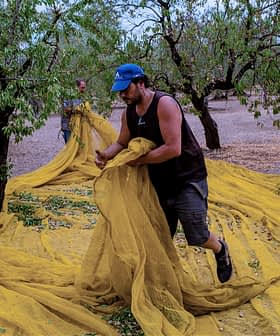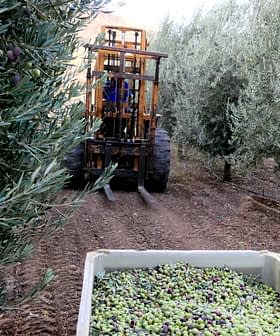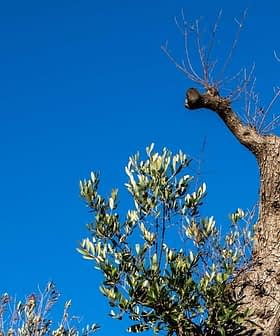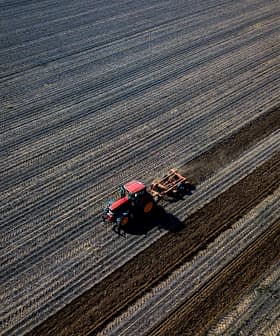Extra chairs lined the walls of the first-floor conference room at the California Farm Bureau Federation in Sacramento for the Olive Oil Commission of California (OOCC) 2016 informational meeting. Sixty people had RSVP’d for the January 13 event, but almost eighty attended.
The OOCC, which falls under the jurisdiction of the California Department of Food and Agriculture (CDFA), was formed by the California olive oil industry for the purpose of developing, verifying and enforcing standards for California olive oil, and for conducting research on olives and olive oil.
Signed into law September 24, 2013 by Governor Brown, and approved by the qualifying growers in March of the following year, the OOCC comprises California producers of over 5,000 gallons of olive oil. The CDFA mandatory Grade and Labeling Standards for Olive Oil, Refined-Olive Oil and Olive-Pomace Oil became effective September 26, 2014. About one-third of the attendees at this informational meeting were California producers of less than 5,000 gallons to learn more about the commission and its work.
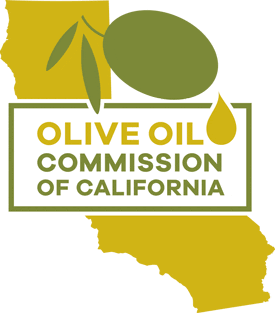
Also attending the program were various olive oil and agricultural industry members: consultants, media, vendors, researchers, political staff, importers and personnel from two industry trade organizations, California Olive Oil Council (COOC) and North American Olive Oil Association (NAOOA).
After introductions by Chris Zanobini, executive director of the OOCC, the program kicked off with a presentation by Albert Katz of Katz Farm, chair of the OOCC Advisory Board, made up of producers of less than 5,000 gallons. Katz, a founding member of the COOC, gave a history of the California industry. Memorably, he quoted a letter from University of California (UC) researcher George Martin to Lila Jaeger, the woman credited with sparking the renaissance of olive oil in California. “Truth in labeling,” warned Martin back in 1991, “will be an issue we have to face.” Katz’s account led to the adoption of the revised USDA olive oil standards in 2010, a move that was spearheaded by California.
Jeff Colombini of Lodi Farming, chair of the OOCC board of directors, picked up with the question “Why a commission?” The main difference between a commission and a trade association is that a commission can levy a mandatory assessment (currently 14 cents/gal) and have mandatory standards. The current USDA standard for olive oil, he pointed out, is voluntary. On the other hand, a commission cannot lobby, and the OOCC specifically cannot engage in promotional activity, so don’t look for the “Got California olive oil?” campaign from them. This remains the bailiwick of the COOC and other trade associations.
Colombini covered the basics of the OOCC’s sampling and testing program, segueing into the next presentation by Paul Miller of the Australian Olive Association (AOA). A seasoned campaigner for better standards around the world, Miller gave a crash course in olive oil testing — what the tests measure and what the results tell us — and explained the context of international standards. He presented a quick summary analysis of the results of the OOCC testing from the 2014 harvest, showing how the results plotted again the levels set in the standard. The 100 samples he presented — 38 from official CDFA testing and 62 from the mandatory handler testing of every lot — were 90 percent extra virgin. 10 percent failed to meet the CDFA standard for extra virgin and, therefore, cannot be labeled as such.
Recently retired as long-time president of the AOA, which has had a quality-testing program for seven years under its Code of Practice, Miller talked about the AOA’s experiences and described the California results as a good outcome and congratulated the growers on a job well done. He also pointed out where the test results presented an opportunity for producers to learn and improve.
Dan Flynn, executive director of UC Davis Olive Center, continued the discussion of the California testing data. The OOCC has funded research projects by the Olive Center to analyze quality and purity data for California olive oils. In the OOCC quality testing from 2014 – 15, six of the 10 failing samples did not meet the sensory standard but passed the chemical parameters. Two of the 10 passed the sensory tests but failed on chemical parameters.
The OOCC analysis of purity data is part of the ongoing effort by olive oil producers in the U.S. and elsewhere to better understand and document the natural variability of olive oil fatty acid and sterol profiles depending on variety, climate, maturity and other factors. For this research, the Olive Center used both commercially produced and lab-extracted monovarietal olive oil samples. The findings were consistent with previous work: A significant number (20% percent) of genuine olive oil samples were found to be outside the official “definition” of olive oil because of a fatty acid or sterol that fell beyond the USDA/CDFA purity parameters. The failing oils were almost all from the desert areas of the state, consistent with global findings that it is the more extreme climate zones that most often result in fatty acid and sterol profiles outside existing standards.
Jim Adaskaveg of the Department of Plant Pathology and Microbiology at UC Riverside discussed a research project funded in part by OOCC on Olive Knot, which has always been an issue for California olive growers but the rise of mechanical harvesting and pruning has resulted in greater challenges for control. The bacteria from the Olive Knot galls require water to spread and must enter the tree through a wound. A leaf scar or frost crack will do, but nicks and cuts from mechanical harvesters are particularly troublesome since rain and harvest so often coincide in the state. Adaskaveg’s team found that quaternary ammonium used as a sterilizer on equipment was very effective in preventing crews from spreading the pathogen.
Similarly, they had excellent control with two new materials used on the trees as a protectant. Traditionally, copper has been used to prevent Olive Knot. Worries about the pathogen developing resistance to copper have spurred interest in alternatives with different modes of action. It appears that two new bactericides, kasugamycin and oxytetracycline, are very effective in preventing infection by Olive Knot. Used in rotation with copper, they could be important tools for managing this disease. Neither of these is currently registered for use in California on olives but efforts are underway.
The afternoon wrapped up with a presentation “Evaluation of Olives as a Host of Xylella fastidiosa (Xf) in California” by Rodrigo Krugner, a research entomologist at the USDA Agricultural Research Service. Krugner’s work isolating the pathogen X. fastidiosa from olive trees, thought to be responsible for a disease called Olive Leaf Scorch in California, led to an unexpected and fascinating finding: when healthy olive trees were inoculated with the pathogen, there was no higher incident of Olive Leaf Scorch in the inoculated plants than there were in the un-inoculated plants. If X. fastidiosa is a factor in Olive Leaf Scorch in California, it is only a part of a much bigger picture.
Also important was a look at the different strains of Xf. There are two strains found in California: X. fastidiosa subsp. fastidiosa, and X. fastidiosa multiplex. The Xf strain causing Olive Rapid Decline Complex in Puglia is X. fastidiosa pauca; the pauca strain has never been found in California. Krugner pointed out that in Italy they have a disease, and they have a bacterium, but no causal relationship has yet been demonstrated. The reason it is being called a “complex” is that there are likely multiple factors that result in the disease.
The OOCC website contains information about the objectives of the commission, copies of the standards, commission documents and a frequently-asked-questions section.

